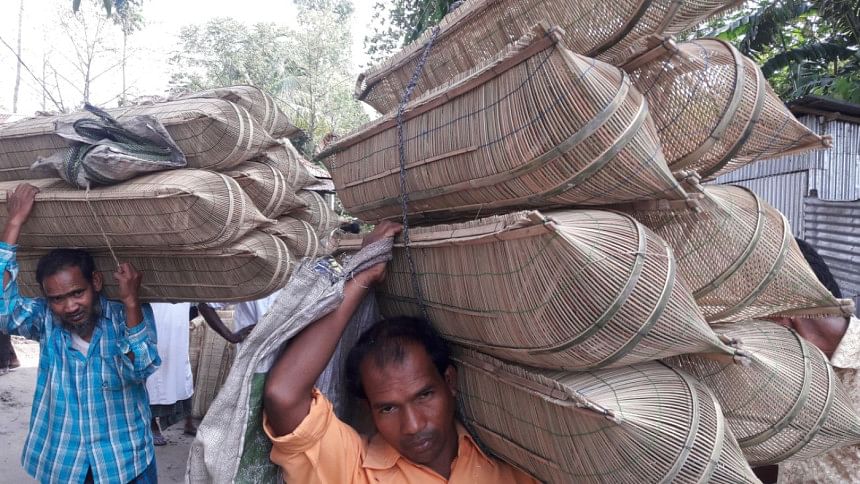Bamboo-made fishing trap in high demand

The traditional method of catching fish with bamboo made fishing trap, locally called teprai, is still popular among the people in the district and even Rangpur region.
Teprai is made in three sizes -- five feet, three feet and two feet in length and one foot in width. Each teprai has five to 10 openings to allow fish to enter, and one pocket for collecting the fish.
Three hundred and fifty families of Kutirpar, Parshuram and Chaparhat villages in Kaliganj upazila become engaged in producing teprai before the monsoon every year. Teprai is supplied to different markets in greater Rangpur's eight districts from these three villages.
Men, women and children make teprai from the middle of May to middle of August, and work as farm labourers or do other jobs in villages for the rest of the year.
One big size teprai is sold at Tk 350 to Tk 400, a middle size one at Tk 250 to Tk 300 and a small size one at Tk 150 to Tk 200 in the markets in the district, but they are sold at higher rates in markets of other districts.
Satish Chandra Barmon, 75, a teprai craftsman of Kutirpar village, told this correspondent that he has been making teprai since his childhood. “Teprai making is our seasonal earning and it is our family work,” he said, adding that each family earns around Tk 60,000 from teprai making in three months during the monsoon.
“We can make at least 10 teprais, including four big size and six middle and small size, with 10 bamboos,” said Shyamol Chandra Roy,32, another teprai craftsman of the same village, adding that each family can produce 30 to 35 teprais every week.
Sumitra Rani, 32, of Parshuram village, said beside her husband Narayan Chandra Barmon, 38, she and their two children also make teprai in their home. She was trained to make teprais after her marriage 13 years ago, and she has been making them since then, she said.
“We don't get wages for making and selling teprai, but we do this traditional work as it is seasonal and family work,” Narayan said.
Teprai trader Jamsher Ali, 42, of Chaparhat village, said he buys the item from the craftsmen in these three villages and supplies those to markets in neighbouring districts. “I earn Tk 70 to Tk 100 from selling each teprai,” he said, adding that they pay advance to teprai craftsmen to get it on time.
Azim Uddin, 58, of Chaparhat village, said they use teprai for catching fish in knee-deep water and get around one to five kg of fish per trip. “We catch fish for four to five hours and mostly get local varieties of fish,” he added.

 For all latest news, follow The Daily Star's Google News channel.
For all latest news, follow The Daily Star's Google News channel. 



Comments